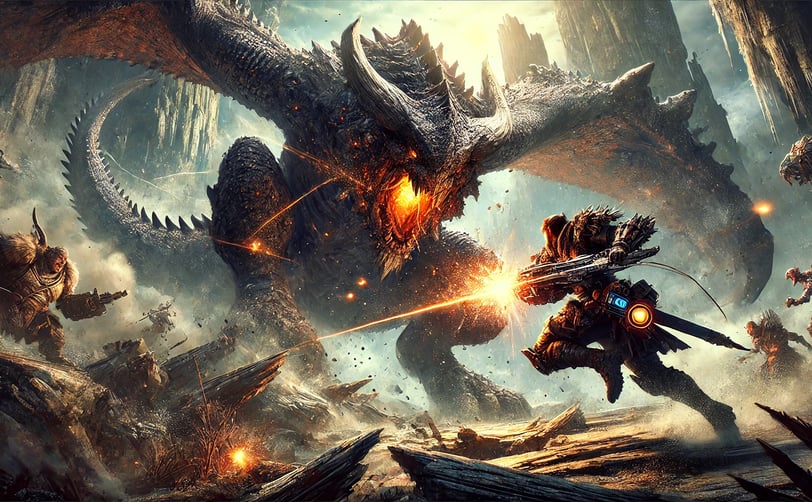Mastering Focus Mode and Wound Mechanics in Monster Hunter Wilds
Unleash Precision and Dominate Hunts with Wilds’ New Combat System Monster Hunter Wilds has introduced groundbreaking mechanics that redefine how hunters engage with its dynamic ecosystem. Among the most impactful additions is Focus Mode, a system that rewards precision and strategy by targeting monster wounds. This guide dives deep into how to master this feature, optimize damage output, and secure rare materials efficiently.
MONSTER HUNTER WILD
3/13/20252 min read


What Are Focus Mode and Wounds?
Focus Mode is a tactical aiming system that highlights vulnerable wounds on monsters. These wounds appear as glowing red areas after sustained attacks on specific body parts. Striking these weak points with Focus Strikes deals massive damage and can even stagger monsters, creating openings for your team.
Key Mechanics
Wound Creation: Repeatedly attack a single body part to create a wound. Weapons like Hammers and Greatswords excel at breaking through tough armor to expose weak spots.
Focus Strikes: Once a wound is active, enter Focus Mode (triggered by a button prompt) to lock onto the weak point. Precision attacks here deal up to 30% more damage and may yield rare materials when the wound is destroyed.
Interrupt Attacks: Focus Strikes can cancel monster abilities mid-animation. For example, hitting a Jin Dahaad’s head during its icy breath charge stops the attack entirely.
How to Optimize Focus Mode
1. Weapon Synergies
Different weapons interact uniquely with Focus Mode:
Dual Blades: Unleash aerial combos by targeting wounds.
Long Sword: Gain Spirit Gauge boosts for landing Focus Strikes.
Bowguns: Use elemental ammo to trigger environmental hazards (e.g., detonating Wylk Crystals for explosive damage).
Pro Tip: Carry two weapons—one for creating wounds (e.g., Hammer) and another for exploiting them (e.g., Bow).
2. Environmental Integration
Monster Hunter Wilds’ living world offers traps and wildlife to amplify Focus Mode:
Paratoads: Lure monsters near these amphibians to paralyze them, creating easy wound opportunities.
Vines and Boulders: Use your Hook Slinger to drop debris on wounded monsters for bonus damage.
3. Skill Builds
Equip armor and weapons with skills tailored to wound mechanics:
Partbreaker: Increases damage to monster parts, accelerating wound creation.
Flayer: Enhances wound frequency.
Evade Window: Dodge monster counters while focusing on weak spots.
Advanced Tactics
1. Dynamic Weak Points
Monsters adapt to wounds by shifting behavior. For example:
Balahara: Creates sand whirlpools when wounded—use these to trap other monsters.
Tempered Monsters: Require breaking glowing blue wounds for unique materials.
2. Team Coordination
In multiplayer hunts:
Assign roles (e.g., one hunter creates wounds, others exploit them).
Use Palico gadgets like the Felyne Barina Needle to apply paralysis, locking monsters in place for Focus Strikes.
3. Sharpness Management
Keep weapons sharp to avoid bouncing off tough hide. Use your Seikret mount to sharpen while chasing fleeing monsters.
Common Mistakes to Avoid
Overcommitting: Focus Mode leaves you vulnerable—time strikes during monster recovery phases.
Ignoring Wylk Crystals: Letting monsters detonate these first wastes free damage opportunities.
Neglecting Field Guides: Study monster weaknesses post-hunt to refine wound strategies.
Conclusion
Focus Mode and wound mechanics are game-changers in Monster Hunter Wilds, rewarding patience and precision. By mastering these systems, hunters can dismantle even the fiercest beasts efficiently while securing rare crafting materials. Pair this knowledge with environmental awareness and adaptive builds, and you’ll dominate the Forbidden Lands in style.
Ready to hunt? Sharpen your blade, prep your Focus Strikes, and carve your legacy in Monster Hunter Wilds! 🐉⚔️
Connect
Join our community for the latest gaming news
